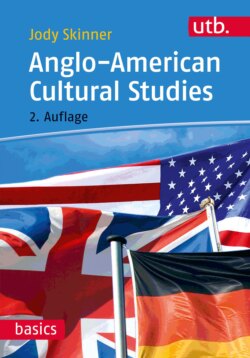Читать книгу Anglo-American Cultural Studies - Jody Skinner - Страница 100
Name a few British leaders during the two World Wars
ОглавлениеFig. 2.13
Statue of David Lloyd GeorgeGeorge, David Lloyd, CardiffCardiff
The first two British leaders aren’t nearly as famous as the last two. But H.H. AsquithAsquith, H.H. is not only worth mentioning because he was the prime minister during the first half of World War IWorld War I but also because of his success in limiting the powerpower of the House of LordsHouse of Lords ( 5) and in laying the framework for what would become the welfare statewelfare state with the help of his successor as prime minister, David Lloyd GeorgeGeorge, David Lloyd, who admired the GermanGerman system of insurance benefits ( 3). Lloyd George is even better known for his part in the Treaty of Versailles and ending World War I and for his helping to end British repression in IrelandIreland. Perhaps Lloyd George, whose native language was WelshWelsh, was more understanding of the Irish than earlier leaders because of his own CelticCeltic background. You can find one statue of him in a dramatic pose in the capital of WalesWales, CardiffCardiff, and another in LondonLondon not far from the most famous prime minister, whom we’ll meet at the end of this section.
If you’ve read the previous pages carefully, you should’ve come across the name of someone who was instrumental in expanding [74]the British EmpireBritish Empire, a man named Joseph ChamberlainChamberlain, Joseph. The key word “appeasement” could make you think of Neville ChamberlainChamberlain, Neville, Joseph’s son, who returned from a meeting with Adolf HitlerHitler in Munich and promised the British “peace with honour” and “peace for our time.” As we all know, Chamberlain wasn’t able to prevent the world war he so desperately wanted to avoid. After the first year of the war brought no victories for the UK, Chamberlain was forced to resign, handing over to probably the most famous of all the more than fifty prime ministers in British history.
blood, toil, tears, and sweatblood, toil, tears, and sweatWinston ChurchillChurchill, Winston’s rhetorical flourishes have echoed through the years. In his very first speech as prime minister, he famously claimed: “I have nothing to offer but blood, toil, tears, and sweatblood, toil, tears, and sweat.” Other stirring speeches were to follow, evidence of Churchill’s skills as an orator and as a writer. While you may not be surprised at Churchill being a NobelNobel Prize winner, would you have expected him to win the Nobel Prize for literature? If you think about another British prime minister mentioned at the beginning of this section, you might even think literary accomplishment was part of the job. Instead of “from VictoriaVictoria to Churchill” we could’ve named this section just “Churchill” since his public service spanned the period from the reign of Victoria to the Cold WarCold War and since he lived to the ripe old age of 90. Churchill was voted the greatest Briton of all times in a BBCBBC poll and regularly appears at the top of lists of the most effective prime ministers. One of the many statues you can find of him across Britain is not far from David Lloyd GeorgeGeorge, David Lloyd directly across the street from Parliament in LondonLondon.
Fig. 2.14
Statue of Winston ChurchillChurchill, Winston
The prime minister who succeeded him, Clement AtleeAtlee, Clement, certainly isn’t as famous but could be judged to have had an even greater impact on contemporary Britain. Why? To answer that question, we need to begin our last section in British history.
